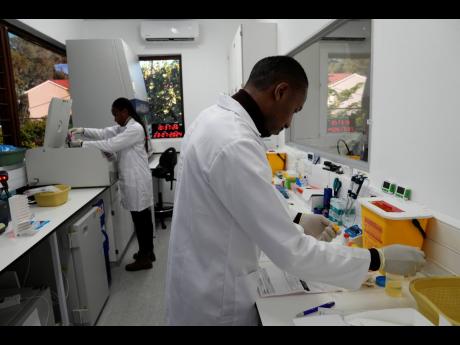Richard Amenyah | The cost of not ending AIDS will be too high
Every minute, a person dies of AIDS somewhere in the world. It’s unsurprising then that the recently published 2024 Global AIDS Report, titled The Urgency of Now: AIDS at the Crossroads, highlighted a grim reality: that the world continues to be off track to end AIDS by 2030. The report calls on global leaders to fulfil their promise to end AIDS as a public health threat, by preventing millions of AIDS-related deaths and new HIV infections from occurring. It also emphasises the need to address the inequalities driving the HIV epidemic and ensure people living with HIV enjoy healthy, fulfilling lives.
Countries that have made significant progress towards these goals have done so by making political and financial choices that prioritise the impact of the AIDS epidemic on their people. These nations have strategically and sustainably invested in services and systems to meet the needs of their populations, reformed laws and policies that reinforced barriers to accessing HIV services, and tackled stigma, discrimination, human rights violations, and gender-based violence. Preventing every new HIV infection eliminates the cost of a lifetime of treatment and care – a critical consideration for policymakers.
The Caribbean, outside of sub-Saharan Africa, has the next highest HIV prevalence at two per cent of the adult population, totalling 340,000 people living with HIV. The epidemic in this region is largely driven by key and vulnerable populations, particularly among those aged 25 to 40 years. However, some countries are seeing a rise in newly diagnosed individuals aged 15 to 24. Like in other regions, socio-cultural factors, including longstanding gender inequalities, discrimination, and poverty, put adolescent girls and young women at greater risk of HIV.
Since 2010, new infections in the Caribbean have generally declined by about 22 per cent, though this is below the global average of 38 per cent. In 2023, there were 15,000 new HIV infections in the region, with 90 per cent of these cases coming from four countries: Cuba, the Dominican Republic, Haiti, and Jamaica. On the other hand, the region reported 5,100 AIDS-related deaths in 2023, representing a decline of about 57 per cent – one of the highest-performing regions globally, alongside Eastern and Southern Africa.
This significant decline in AIDS mortality is largely attributable to the scale-up of treatment across the region. However, despite this progress, there are still 100,000 people either yet to be identified, who know their status but have not been linked to care, or who have dropped out of care for various reasons. Low personal risk perception, fear of stigma, and discrimination are significant barriers preventing individuals from protecting themselves against HIV and getting tested. Globally, about one-third of people living with HIV report feeling ashamed of their status – a form of internalised stigma. In Jamaica, more than half of people living with HIV reported feeling ashamed or worthless.
PREJUDICE AND STIGMA
Key and vulnerable populations in the Caribbean continue to experience prejudice, stigma, and discrimination in various settings, including at home and communities, in the workplace, in healthcare facilities, and from law enforcement and religious leaders. This pushes them underground, preventing access to essential HIV services. High levels of gender-based violence, including sexual violence, further contribute to HIV exposure. Some countries in the region have passed protective legislation, such as domestic violence acts with deterrent measures, fines, and imprisonment for violators.
In the Caribbean, about a quarter of people initiated on treatment present with advanced HIV disease, making their care more costly due to the need to treat opportunistic infections before starting antiretroviral therapy. Stigma and discrimination are likely major contributory factors, as many people delay seeking care due to the fear of shame and dying from an incurable disease. The early 2000s saw many communities ravaged by these fears. However, the scale-up of antiretroviral treatment has brought people back from the brink of death, providing hope for households and communities.
Supporting people living with HIV to promptly initiate and continue antiretroviral therapy is crucial, especially as evidence shows that those on treatment who achieve undetectable viral load levels pose no risk of HIV transmission to their partners. This underscores the importance of effective HIV treatment in preventing new infections, leading to the ‘undetectable = untransmittable’ (U=U) campaign. Despite the successes of antiretroviral treatment, ignorance about HIV and treatment possibilities, along with the stigma associated with the disease, prevents some people from accessing care.
COMMUNITY-LED MONITORING
Some countries, including Jamaica and Haiti, have implemented community-led monitoring systems involving people living with HIV to enhance service quality and effectiveness. These systems address stigma and discrimination through community advocacy and action, creating an enabling environment to address inequalities, break down barriers, and improve access to HIV services, including seeking legal redress for rights violations. Scaling up these initiatives in other countries will help eliminate gender disparities in treatment access, where only 65 per cent of men are on treatment compared to 78 per cent of women. The disparity between adults and children is also stark, with 70 per cent of adults on treatment compared to only 39per cent of the estimated 11,000 children living with HIV.
To reduce HIV among children through the elimination of vertical transmission from mother to child, the Caribbean has been a global leader, with 11 out of 17 countries and territories validated so far. This success has contributed to fewer children living with HIV in the region. However, it is imperative for policymakers and program managers review strategies for identifying the remaining 7,000 children living with HIV and providing them with life-saving treatment. All countries should ensure that pregnant women living with HIV have access to antiretroviral treatment during pregnancy, labour, delivery, and breastfeeding. HIV-exposed babies should be tested within two months of birth using innovative point-of-care technology as part of early infant diagnosis.
Addressing poor access to testing for children improves their chances of being linked to care and receiving life-long antiretroviral treatment. Research shows that without early initiation of treatment, about one-third of children infected with HIV at birth will not live to celebrate their first birthday, and about 50 per cent will not live to see their second birthday. Strengthening community systems and healthcare systems, especially maternal and child health services, is crucial for the continuum of care and treatment for children living with HIV. Family-based index testing has demonstrated tremendous success in diagnosing older children living with HIV who were missed through early testing strategies or who were never tested after breastfeeding. Psychosocial counselling and social support for affected households and communities are essential as part of the overall care package for children and adolescents living with HIV.
To protect the gains made in the HIV response and ensure sustainability, health policymakers should invest more in integrating HIV and other health services, especially at the primary health care level, including non-communicable diseases and mental health services. This will enhance HIV treatment and prevention outcomes and support the achievement of universal health coverage.
CALL FOR ACTION
Our political leadership must keep their promise to put people and communities first in policies and programmes by providing adequate financial resources to invest in evidence-based interventions to end the AIDS epidemic. As we celebrate the progress achieved so far, it is clear it is insufficient, and there must be no room for complacency. We need to continue the fight to prevent new HIV infections and save more lives. The evidence is clear: every dollar invested in preventing new HIV infections and AIDS-related deaths generates up to $6.44 in economic returns in low- and middle-income countries.
Policymakers must remember that AIDS is not just a health issue; it is a development issue, and the cost of not ending AIDS will be too high. Globally, if we fail to achieve the agreed targets, there could be about 18 million AIDS-related deaths and almost 35 million new HIV infections by 2050. This will cost everyone in low and middle-income countries about $8,300 – a price too high to pay to end AIDS. Addressing structural barriers and intersecting inequalities is key to the response to end AIDS as a public health threat. Action by our leaders to reduce inequalities will advance the Sustainable Development Goals (SDGs) and prepare Caribbean countries to tackle future pandemics, creating a safer and fairer world for all. The Caribbean must seize the opportunity at the upcoming Summit of the Future this September, where world leaders will chart the path for accelerating the 2030 Agenda and the pledge to leave no one behind. This will ensure that the gains in the HIV response are protected beyond 2030 and lead to the realisation of an HIV-free generation in the region.
Dr Richard Amenyah is a medical doctor and public health specialist. He is the director for the UNAIDS multi-country office for the Caribbean. Follow him on X (formerly Twitter) at @RichardAmenyah or @UNAIDSCaribbean. Send feedback to jamaica@unaids.org.


